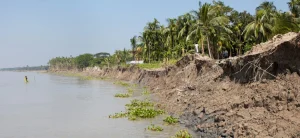Rivers Are Swallowing Homes: Erosion Crisis Reshaping Northern Bangladesh

When Land Turns Into Water
Across northern Bangladesh, families living along the Brahmaputra and Teesta rivers are watching their land disappear metre by metre. Accelerating river erosion—fueled by heavier monsoon flows, glacial melt and weakened embankments—is pushing households into sudden displacement. When a homestead collapses, the losses multiply: farmland vanishes, children must change schools, and families lose the community bonds that defined their identity.
Many who depended on seasonal crops or fishing are forced into low-wage urban jobs. The emotional toll is immediate—decades-old homes, ancestral fields and neighbourhoods can vanish within days. For disaster response teams, relocating entire villages demands resources that are often stretched thin.

A Social and Economic Turning Point
River erosion is not just an environmental crisis—it is redrawing Bangladesh’s socio-economic landscape. Shrinking farmland worsens rural poverty and food insecurity. Large-scale displacement fuels migration to major cities that are already overburdened. Policymakers are under growing pressure to reinforce embankments, upgrade early-warning systems and create structured relocation plans before the next monsoon cycle.
Meanwhile, communities are adapting as best they can—building savings groups, preparing gradual relocation strategies and exploring alternative livelihoods. But the underlying reality remains: in many areas, staying on ancestral land is no longer safe, and families are being forced to choose between home and survival.




















